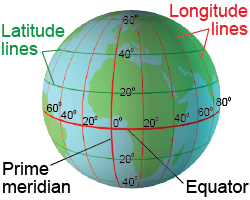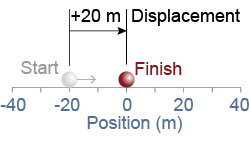|
This section looks at how physics describes and quantifies object locations. By the end of this section you should be able to apply the concepts of position, coordinates, vectors, and displacements to scenarios involving motion. 
|
Distance and position
|
Space has dimensions of length, and distance is the separation between any two points in space. Saying an object is 3 m away does not tell you where the object is located, however, because distance does not include any information about the starting position or the direction of the motion. 
|

|
Position in physics means a unique location in space with reference to an origin and a coordinate system. A position of −0.50 m is a half meter to the left of the start of the meter stick. The position of −0.5 meters is different from a distance of 0.5 m because position implies an origin. 
 |
 In two and three dimensions the set of position values along the x, y, and z axes are called coordinates. When we say space is three dimensional, we actually mean that we can uniquely assign a position to every point in space using only three numbers. The three numbers are called coordinates and you have an intuitive knowledge of them already. If you imagine the center of your chest as the origin, then the three dimensions of space are shown in the diagram on the right.
In two and three dimensions the set of position values along the x, y, and z axes are called coordinates. When we say space is three dimensional, we actually mean that we can uniquely assign a position to every point in space using only three numbers. The three numbers are called coordinates and you have an intuitive knowledge of them already. If you imagine the center of your chest as the origin, then the three dimensions of space are shown in the diagram on the right. - Right–left is assigned to the x-axis with positive being to the right.
- Up–down is assigned to the y-axis with positive being up.
- Forward–backward is assigned to the z-axis with positive being forward.
With three coordinates, you can precisely locate any point in space relative to your origin. Most of Chapter 3 deals with one-dimensional motion in which objects move in a straight line so only a single number is needed to describe position. Think of one–dimensional motion as being constrained to the x-axis with no ability to move in the y– or z–direction. Motion in two and three dimensions is addressed in Chapter 6 and the subsequent chapters. 
|
 The origin is a fixed reference point that you choose. In laboratory experiments you might choose the origin to be a particular point on the table or the top of a ramp. The key idea is that all position measurements are given relative to the same origin point; otherwise you would not know how to interpret them correctly. GPS devices use latitude and longitude to specify position on Earth’s surface relative to zero longitude at the prime meridian in Greenwich, England.
The origin is a fixed reference point that you choose. In laboratory experiments you might choose the origin to be a particular point on the table or the top of a ramp. The key idea is that all position measurements are given relative to the same origin point; otherwise you would not know how to interpret them correctly. GPS devices use latitude and longitude to specify position on Earth’s surface relative to zero longitude at the prime meridian in Greenwich, England. 
|
 A displacement is a change in position. Displacement can have positive and negative values, as can position. When negative is defined to be left of the origin, a negative displacement is to the left. A positive displacement is to the right. The position of an object is equal to its starting position plus any displacement.
A displacement is a change in position. Displacement can have positive and negative values, as can position. When negative is defined to be left of the origin, a negative displacement is to the left. A positive displacement is to the right. The position of an object is equal to its starting position plus any displacement. 
|
Describe an action that will take you from your seat to the classroom door without using the word “displacement.” What other words or phrases mean the same thing? For example, you might say, “I should _________ about three meters to my left and two meters straight ahead.” You don’t need exact distances, just an estimate. 
|
 A ball undergoes a displacement of −20 m from its initial position shown in the diagram. Which of the following is true?
A ball undergoes a displacement of −20 m from its initial position shown in the diagram. Which of the following is true? - The ball moves a total distance of −30 m.
- The ball moves a total distance of 30 m.
- The ball ends up at a position of −30 m.
- The ball ends up at a position of +10 m.
 |
The answer is c, the ball ends up at a position of −30 m. The ball begins at a position of −10 m. If it moves another −20 m from where it begins, it will end up at −10 + (−20) = −30 m. It doesn't matter what path the ball takes to get there, but it does end up 20 m to the left of where it started. 
|

